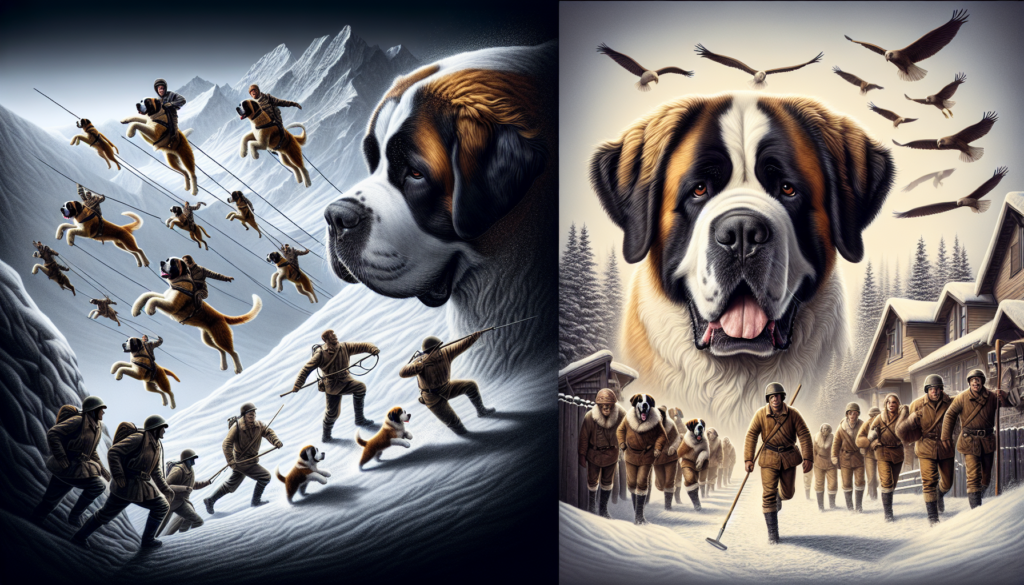Get ready to embark on a fascinating journey into the storied history of Saint Bernard breeding. This beloved breed of dogs has a rich and intriguing past, captivating dog enthusiasts and history buffs alike. From their origins in the Swiss Alps to their renowned role as rescue dogs, Saint Bernards have left an indelible mark on our hearts. Delve into the captivating details behind what Saint Bernards were bred for, and prepare to be amazed by their remarkable lineage.

Early Origins
The Saint Bernard Monastery
The history of Saint Bernard breeding traces back to the iconic Saint Bernard Monastery in the Swiss Alps. The monks of this hospice began breeding dogs for their role in search and rescue operations, which were essential for helping lost travelers navigate the treacherous mountain passes. The harsh conditions and demanding nature of their work required a robust and capable breed.
The Original Breeding Purpose
Initially, Saint Bernards were bred for their strength, endurance, and ability to navigate through deep snow. They needed to be able to locate and guide lost or injured individuals back to safety. These dogs played a crucial role in rescuing stranded travelers, often risking their own lives in the process. They were highly valued for their loyalty, intelligence, and gentle temperament.
Development of the Breed
Selective Breeding Practices
To ensure the continuation of desirable traits, the monks engaged in selective breeding practices. Dogs with exceptional search and rescue abilities were chosen as breeding stock, passing down their traits to future generations. The selection process focused on dogs with sturdy frames, large size, powerful build, and an instinctual knack for finding lost individuals. Over time, these traits became synonymous with the breed.
Influence of Other Breeds
While the Saint Bernard breed developed primarily through selective breeding, it is believed that other breeds, such as the Newfoundland and the Great Pyrenees, also played a role in shaping the breed we know today. These breeds brought qualities like strength, endurance, and a thick coat to withstand the harsh alpine climate. This infusion of diverse genetic material enhanced the breed’s abilities and contributed to its distinctive appearance.
Recognition and Standardization
First Breed Standard
In the early days, there was no formal breed standard for Saint Bernards. Each breeding was based on the individual capabilities and characteristics of the dogs involved. However, as interest in the breed grew, efforts were made to establish a standard to maintain consistency in appearance and temperament. The first official breed standard for Saint Bernards was recorded in 1884, outlining the desired qualities and physical attributes of the breed.
Recognition by Kennel Clubs
The recognition and standardization of the Saint Bernard breed led to its acceptance by various kennel clubs worldwide. The Swiss St. Bernard Club was formed in 1884, and the breed gained recognition from influential kennel clubs such as the Fédération Cynologique Internationale (FCI) and the American Kennel Club (AKC). These organizations helped promote responsible breeding practices and set guidelines for maintaining the breed’s integrity.
Prominent Figures in Saint Bernard Breeding
Barry and His Legacy
One of the most renowned Saint Bernards in history was Barry, who lived at the Saint Bernard Hospice during the early 1800s. Barry was credited with saving the lives of numerous stranded travelers and established a legacy that epitomizes the breed’s devotion and heroism. His tales became legendary and inspired future generations of Saint Bernard breeders to continue breeding dogs with similar qualities.
Monks of the Saint Bernard Hospice
The monks of the Saint Bernard Hospice played a critical role in the development and preservation of the Saint Bernard breed. Their dedication to breeding dogs with excellent search and rescue abilities ensured the breed’s continuity. They meticulously maintained records of each generation of dogs and carefully selected the strongest and most reliable individuals to carry on the breed’s noble purpose.

Popularity and Expansion
Rapid Spread of the Breed
The popularity of the Saint Bernard breed quickly spread beyond the Swiss Alps. As stories of their heroism and gentle nature became known, demand for these remarkable dogs grew. They were sought after by individuals living in mountainous regions and even by those seeking them as family pets. The breed’s reputation as a loyal companion and its impressive working abilities contributed to its rapid expansion.
Introduction to Other Countries
With the growing demand for Saint Bernards, dogs from the Saint Bernard Hospice were introduced to other countries to establish breeding programs. This international expansion helped solidify the breed’s presence worldwide and ensured a diverse gene pool. Saint Bernards were received enthusiastically, particularly in countries with alpine regions, where their search and rescue skills were highly valued.
Working Abilities and Field Use
Tradition of Search and Rescue
The Saint Bernard breed’s primary purpose has always been search and rescue. Their well-developed sense of direction, exceptional smell, and remarkable endurance made them indispensable in locating lost or injured individuals in mountainous terrain. The breed’s massive size and strength allowed them to traverse deep snow and rescue stranded travelers, often pulling them to safety on sleds or by attaching Alpine collars.
Other Utilitarian Tasks
Apart from search and rescue, Saint Bernards were also adept at performing various other utilitarian tasks. They excelled in hauling heavy carts, guarding livestock, and providing protection to their owners. Their gentle and calm temperament made them ideal therapy dogs, providing comfort and support to those in hospitals or rehabilitation centers. Their versatility and willingness to work made them truly invaluable.
Modern Challenges
Health Concerns
Like many large breeds, Saint Bernards are susceptible to certain health concerns. The breed is known to experience issues such as hip and elbow dysplasia, heart conditions, and bloat. Responsible breeders prioritize health testing and carefully select breeding pairs to reduce the incidence of these inherited conditions. Regular veterinary care, a balanced diet, and appropriate exercise are crucial for maintaining the well-being of this majestic breed.
Maintaining Breed Characteristics
Preserving the breed’s desirable characteristics while addressing modern challenges can be a delicate balance. Careful breeding practices aim to maintain the Saint Bernard’s iconic appearance, gentle temperament, and working abilities. Striking a balance between preserving the breed’s heritage and introducing genetic diversity becomes essential to ensure the breed’s long-term viability and well-being.
Saint Bernard in Popular Culture
Famous Saint Bernards
The Saint Bernard breed has gained immense popularity in popular culture, often depicted as a lovable and loyal companion. Several famous Saint Bernards have captured the hearts of people around the world. Perhaps the most famous is “Nana” from J.M. Barrie’s Peter Pan, known for her nurturing nature. Other notable Saint Bernards in popular culture include the lovable Beethoven from the film series of the same name and Cujo, the terrifying Stephen King novel and film adaptation.
Literary and Film References
Saint Bernards have also made appearances in various literary works and films. Their reputation as gentle giants and heroic rescuers has made them a beloved subject. From being featured in classic literature like Lord Byron’s poem “Epitaph to a Dog” to their portrayal in films such as “The Mountain Between Us,” the breed’s remarkable history and characteristics continue to captivate and inspire.
Breeding Organizations and Code of Ethics
Key Breeding Organizations
Several breeding organizations play a vital role in promoting responsible Saint Bernard breeding practices. The Swiss St. Bernard Club and the Saint Bernard Club of America are two major organizations dedicated to upholding breed standards, educating breeders, and assisting in preserving the integrity of the breed. These organizations emphasize health testing, ethical breeding practices, and the welfare of the dogs.
Considerations for Responsible Breeding
Responsible breeders understand the importance of selecting healthy individuals with sound temperaments for breeding. They prioritize health testing to identify and minimize the risk of genetic conditions. Ethical breeders also consider the overall well-being of their dogs, providing them with adequate nutrition, exercise, socialization, and veterinary care. By adhering to a code of ethics, breeders help ensure the continued well-being of the Saint Bernard breed.
The Future of Saint Bernard Breeding
Adaptation to Changing Needs
As times change, the needs of the Saint Bernard breed also evolve. While their search and rescue abilities remain crucial, the breed’s gentle nature and adaptability make them suitable for various roles. Saint Bernards have excelled in therapy work, providing emotional support to individuals in need. Breeders must adapt to these changing needs and continue to produce well-rounded dogs capable of fulfilling both traditional and modern roles.
Balancing Tradition with Genetic Diversity
Preserving the breed’s unique heritage while incorporating genetic diversity is vital for its long-term survival. Careful breeding practices that ensure the health, temperament, and working abilities of Saint Bernards should be implemented while preventing excessive inbreeding. Balancing tradition with genetic diversity helps maintain the breed’s distinct qualities while minimizing the risk of inherited health issues.
In conclusion, the history of Saint Bernard breeding is a testament to the breed’s remarkable abilities, gentle temperament, and unwavering loyalty. From their origins in the Saint Bernard Monastery to their worldwide recognition and presence in popular culture, the breed has made an indelible impact. Responsible breeding practices, coupled with the adaptability to changing needs, will ensure a bright future for Saint Bernard breeding, as these magnificent dogs continue to touch the lives of people around the world.
